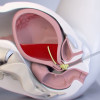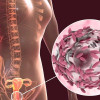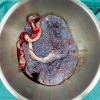.jpg)
 IJCP Editorial Team
IJCP Editorial Team
A Huge Gartner's Cyst
A report describes a case of a 38-year-old lady, para 2 live 2, sterilized, who complained of a painless mass descending per vaginum for seven years.
She reported the mass to be initially small in size that gradually increased over a period of time to cause severe dyspareunia. The mass was nonreducible and caused friction during walking. She denied difficulty in micturition or passage of stools, dysmenorrhoea, or any associated medical disorders. Her menstrual cycles were regular with a moderate flow. Initial examination revealed a cystic mass with solid components of size 9 x 4 cm protruding through the vagina, with the surface being smooth and pale pink in color. The base of the mass extended to bilateral lateral walls.
Per speculum examination revealed a bulky cervix, which was visualized separately from the mass. Per vaginal examination, showed cervix high up, away from the base of the mass. Thus ruling out the possibility of pelvic organ prolapse.
The patient's uterus was anteverted, normal in size, and mobile, with unremarkable bilateral fornices, a free pouch of Douglas, and no associated pain, hence ruling out the possibility of endometriosis. Since the mass was painless and a needle aspiration did not yield any content, a diagnosis of Bartholin's cyst/abscess was ruled out, while a provisional diagnosis of Gartner's cyst was created owing to the location of the cyst, and the patient was planned for cyst excision.
On passing a bladder sound, the tip of the sound was palpable within the mass. Hence, an on-table decision to perform a cystoscopy was taken.
Cystoscopy, using a 30-degree cystoscope, showed no evidence of bladder diverticulum. Since the diagnosis was inconclusive, surgery was abandoned, and an MRI was done on the following day, which established the diagnosis of Gartner's cyst and clearly excluded the possibility of a bladder diverticulum.
The patient was scheduled for surgical excision of Gartner's cyst, and the procedure was undertaken, followed by a histopathological examination that revealed a non-mucin-secreting low columnar and cuboidal epithelium, consistent with a Gartner's cyst. On one month follow-up, the patient showed good recovery.
Indu NR, Hiremath PB, Reshmi M, Supriya MS, Hiremath R. Case report of a huge Gartner's cyst. Indian J ObstetGynecol Res. 2023;10(1):67-69

IJCP Editorial Team
Comprising seasoned professionals and experts from the medical field, the IJCP editorial team is dedicated to delivering timely and accurate content and thriving to provide attention-grabbing information for the readers. What sets them apart are their diverse expertise, spanning academia, research, and clinical practice, and their dedication to upholding the highest standards of quality and integrity. With a wealth of experience and a commitment to excellence, the IJCP editorial team strives to provide valuable perspectives, the latest trends, and in-depth analyses across various medical domains, all in a way that keeps you interested and engaged.





















Please login to comment on this article